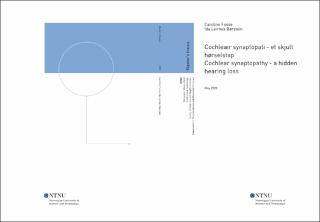| dc.description.abstract | Introduksjon: Dyreforskning har antydet at cochleær synaptopati (CS), dvs. tapet av de synaptiske forbindelsene mellom de indre hårcellene og de auditive nervefibrene, kan oppstå som følge av aldring og/eller støyeksponering uten at hårcellene i cochlea påvirkes. CS kan gå utover den auditive funksjon ved at hjernen får et redusert antall signaler transmittert fra de indre hårcellene, uten at høretersklene påvirkes permanent. På denne måten blir CS en form for skjult hørselstap (Hidden Hearing Loss “HHL”), som man per i dag ikke vet hvordan man skal diagnostisere på mennesker.
Hensikt: Målet med studien var å bidra med materiale og betraktninger inn mot det fremtidige målet; å finne en klinisk metode for å diagnostisere cochleær synaptopati hos mennesker.
Metode: For å svare på vår problemstilling har vi benyttet litteraturstudie som metode, slik at vi kunne anvende eksisterende forskning til å identifisere en ny kunnskap på tvers av materialet. Vi har analysert og sammenlignet ti kvantitative forskningsartikler, som undersøker CS hos mennesker som en konsekvens av aldring og/eller støyeksponering. Resultat: En rekke fysiologiske og psykoakustiske målinger ble analysert, for å undersøke om de kunne bidra til å indikere CS hos mennesker. Det var en stor variasjon mellom testresultatene, der majoriteten av testene ikke oppnådde signifikante resultater.
Konklusjon: Den manglende konsensusen rundt hvilke tester som kan benyttes for å diagnostisere CS indirekte på mennesker, gjør at det er en rekke metodiske faktorer som potensielt påvirker testresultatene, og som er viktige å ta i betraktning ved fremtidig forskning. Når det er nevnt tror vi, basert på resultatene i våre artikler, at måling av bølge I/V forhold, latenstiden ved auditiv hjernestammerespons (ABR) og undersøkelse av SP/AP- forholdet ved ECochG kan være mest effektive for indikasjon på CS, såfremt metodene utføres i henhold til de spesifikke kravene som ga resultater i artiklene vi analyserte. Det er likevel viktig å understreke at vårt grunnlag for å komme med konkrete tester er svært begrenset. | |
| dc.description.abstract | Introduction: Animal studies have suggested that cochlear synaptopathy (CS), i.e. the loss of the synaptic connections between the inner hair cells and the auditory nerve fibres, might occur as a consequence of aging and/or noise exposure, without requiring a loss of hair cells. CS might affect the auditory function, as the amount of auditory signals transmitted to the brain from the inner hair cells decreases, without affecting the hearing threshold permanently. As the hearing deficit caused by CS can’t be measured using pure tone audiometry, it falls under the umbrella term “hidden hearing loss” (HHL), which describes various forms of hearing losses that lack a diagnostic method that are valid for humans.
Objective: The objective of this study was to contribute with material and considerations towards the future goal of obtaining a clinical method for diagnosing cochlear synaptopathy. Design: In order to fulfill our objective, we chose a literature review as our method, as this would aid us in gathering and analyzing existing material on the topic in order to gain new insight. We examined ten quantitative studies which all deployed various tests in order to identify CS caused by age or noise in a sample human population.
Result: Several physiological and behavioral measures were analyzed, in an attempt to assess their effectiveness towards identifying CS in human subjects. There was a considerable variation between the observed test results, where most of the measures did not achieve results of significance.
Conclusion: The lack of consensus on whether CS is detectable in humans, underlines the importance of the various methodological factors in this research. Variations in the test results, might stem from a lack of rigorous criteria with regards to execution of test methods and selection criteria for the participants. Based on the comparison of the results derived from our selection of articles, however, it seems that the tests for auditory brainstem response (ABR) wave I/V ratio, wave V latency and the examination of the SP/AP ratio by ECochG might seem to be most effective test methods to indicate CS going forward, given that the tests are executed in a specific manner that seemed to yield results in our literature study. However, it is important to emphasize that our research material was limited, thus our conclusion should be considered with that in mind. | |
